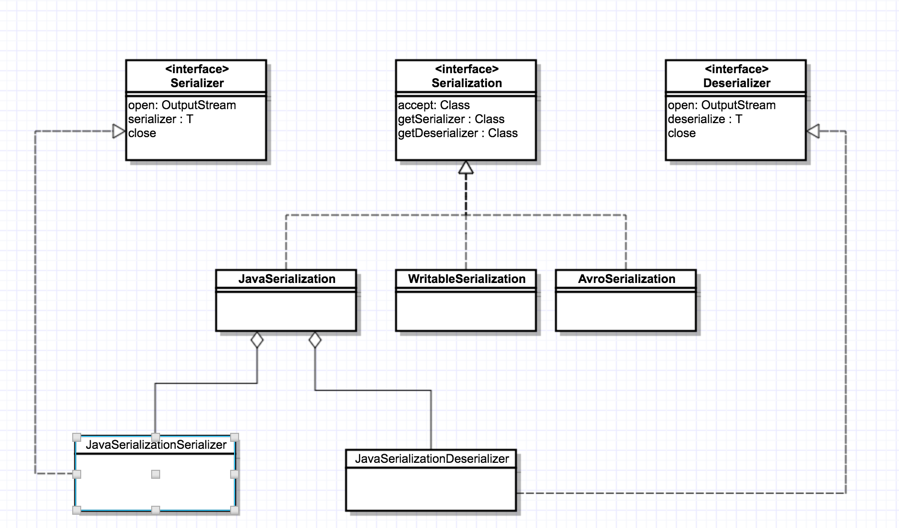hadoop 序列化框架
[toc]
序列化,反序列化
序列化: 按照一定格式把一个对象编码成一个字节流,可以存储在硬盘,可以在网络中传递,可以拷贝,克隆 等, 反序列化: 把存入字节流的对象,解析成一个对象。
java 序列化
序列化接口: Serializable 输入输出: ObjectInputStream 和 ObjectOutputStream 的 readObject() 和writeObject() 序列化内容:对象类,类签名,非静态成员变量值,所有父类对象,其他引用的对象等
hadoop序列化
Writable接口
InterfaceAudience.Public
InterfaceStability.Stable
public interface Writable {
/**
* 输出对象到数据流中
*/
void write(DataOutput out) throws IOException;
/**
* Deserialize the fields of this object from <code>in</code>.
* 从流中读取对象,为了效率,尽可能复用现有对象
*/
void readFields(DataInput in) throws IOException;
}
介绍几个重要的接口:
WritableComparable : 有比较能力的序列化接口,同时继承了writable 和 comparable 接口, ByteWritable,IntWritable,DoubleWritable 等java 基本类型对应的Writable 都继承了这个接口 RawComparator : 允许从流中读取未被反序列化的对象进行比较。 WritableComparator : RawComparator 的通用实现类
例子 ObjectWirtable 类
主要成员变量
//需要序列化,反序列化的类名
private Class declaredClass;
//被封装的对象的实例
private Object instance;
private Configuration conf;
序列化方法
@Override
public void write(DataOutput out) throws IOException {
writeObject(out, instance, declaredClass, conf);
}
public static void writeObject(DataOutput out, Object instance,
Class declaredClass,
Configuration conf) throws IOException {
writeObject(out, instance, declaredClass, conf, false);
}
public static void writeObject(DataOutput out, Object instance,
Class declaredClass, Configuration conf, boolean allowCompactArrays)
throws IOException {
//判断实例是不是为null
if (instance == null) { // null
instance = new NullInstance(declaredClass, conf);
declaredClass = Writable.class;
}
//判断是不是基本类型的数组
// Special case: must come before writing out the declaredClass.
// If this is an eligible array of primitives,
// wrap it in an ArrayPrimitiveWritable$Internal wrapper class.
if (allowCompactArrays && declaredClass.isArray()
&& instance.getClass().getName().equals(declaredClass.getName())
&& instance.getClass().getComponentType().isPrimitive()) {
instance = new ArrayPrimitiveWritable.Internal(instance);
declaredClass = ArrayPrimitiveWritable.Internal.class;
}
UTF8.writeString(out, declaredClass.getName()); // always write declared
if (declaredClass.isArray()) { // non-primitive or non-compact array
int length = Array.getLength(instance);
out.writeInt(length);
for (int i = 0; i < length; i++) {
writeObject(out, Array.get(instance, i),
declaredClass.getComponentType(), conf, allowCompactArrays);
}
} else if (declaredClass == ArrayPrimitiveWritable.Internal.class) {
((ArrayPrimitiveWritable.Internal) instance).write(out);
} else if (declaredClass == String.class) { // String
UTF8.writeString(out, (String)instance);
//判断是否是基本类型
} else if (declaredClass.isPrimitive()) { // primitive type
if (declaredClass == Boolean.TYPE) { // boolean
out.writeBoolean(((Boolean)instance).booleanValue());
} else if (declaredClass == Character.TYPE) { // char
out.writeChar(((Character)instance).charValue());
} else if (declaredClass == Byte.TYPE) { // byte
out.writeByte(((Byte)instance).byteValue());
} else if (declaredClass == Short.TYPE) { // short
out.writeShort(((Short)instance).shortValue());
} else if (declaredClass == Integer.TYPE) { // int
out.writeInt(((Integer)instance).intValue());
} else if (declaredClass == Long.TYPE) { // long
out.writeLong(((Long)instance).longValue());
} else if (declaredClass == Float.TYPE) { // float
out.writeFloat(((Float)instance).floatValue());
} else if (declaredClass == Double.TYPE) { // double
out.writeDouble(((Double)instance).doubleValue());
} else if (declaredClass == Void.TYPE) { // void
} else {
throw new IllegalArgumentException("Not a primitive: "+declaredClass);
}
} else if (declaredClass.isEnum()) { // enum
UTF8.writeString(out, ((Enum)instance).name());
} else if (Writable.class.isAssignableFrom(declaredClass)) { // 其他实现了writable接口的类型
UTF8.writeString(out, instance.getClass().getName());
((Writable)instance).write(out);
} else if (Message.class.isAssignableFrom(declaredClass)) {
((Message)instance).writeDelimitedTo(
DataOutputOutputStream.constructOutputStream(out));
} else {
throw new IOException("Can't write: "+instance+" as "+declaredClass);
}
}
上边介绍的writable 接口的序列化,主要应用在mapreduce 过程中输入输出,但是hadoop还支持了其他序列化方法,包括hadoop Avro, Apache Thrift 和Google Protocol Bufferd等但是这些主要应用在远程rpc通信。对应数据存储例如:map的输出,reduce输出等就主要用到writable接口实现的类。
hadoop简单的序列化框架

接口 Serialzation
方法:
//判断序列化实现是否支持该类对象
boolean accept(Class<?> c);
//获取用于序列化的对象Serializer的实现
Serializer<T> getSerializer(Class<T> c);
//获取用于反序列化的对象Deserializer实现
Deserializer<T> getDeserializer(Class<T> c);
接口 Serializer
//打开流,为序列化准备
void open(OutputStream out) throws IOException;
//开始将对象序列化到流中
void serialize(T t) throws IOException;
//关闭流,结束序列化,清理
void close() throws IOException;
接口 Deserializer
与序列化过程类似
java序列化支持
主要实现了Serialzation 接口,并且有两个静态内部类JavaSerializationDeserializer 和 JavaSerializationSerializer 分别实现Deserializer 和Serializer 接口 具体代码可以查看 hadoop 项目hadoop-common 的org.apache.hadoop.io.serializer.JavaSerializationl 类。WritableSerialization 和AvroReflectSerialization 也有类似的实现。





















 8981
8981











 被折叠的 条评论
为什么被折叠?
被折叠的 条评论
为什么被折叠?








